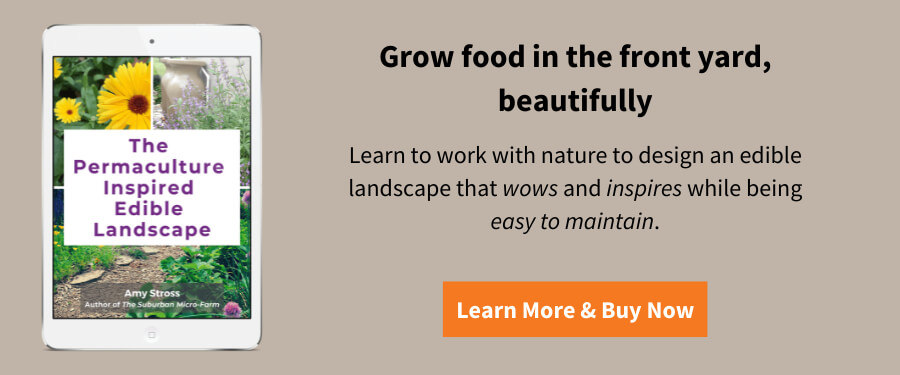Many spring ephemerals—such as daffodils—dazzle the early season with their colorful flowers. But their benefit to the ecosystem extends beyond beauty. Learn about spring ephemerals and how they can benefit a permaculture garden.

This page may contain affiliate links. Please read my disclosure for more info.
What are Spring Ephemerals?
Daffodils are spring ephemerals—herbaceous plants that live in deciduous forests. Ephemeral means “lasting for a very short time”. They leaf out, gather energy, flower, and reproduce in the early spring before the canopy trees leaf out.
During their short time of spring activity, they have access to full sun conditions while other plants are still dormant. This period fuels their energy needs for the entire year. They are also largely resistant to deer and other animals.
Daffodils and other spring ephemerals will reproduce by setting seed as well as by sending out new shoots from the root bulbs. This is why spring ephemerals usually grow in patches or colonies.
Once the trees and shrubs surrounding them begin leafing out and temperatures start to warm up, spring ephemerals are signaled that it is time to go dormant until the following year. The leaves and flowers will die back naturally for the season.
Ecological Benefits of Spring Ephemerals
Spring ephemerals contain a high level of nutrients. That’s because the early spring rains are rich in nutrients.
As the spring rains wash over an area, they take topsoil and organic matter with them. Spring ephemerals—with their root systems being active during this time—catch and hold the moisture and important nutrients and prevent them from leaching away.
For this reason, spring ephemerals can prevent soil erosion. They will even do well planted on a slope as part of a hillside stabilization plan.
When spring ephemerals die back at the end of the spring season, the excess nutrients they collected will then enrich the plants and trees that surround them.
Growing Spring Ephemerals in the Permaculture Garden
Daffodils and other spring ephemerals can benefit the permaculture garden in many ways. They provide nectar for early season pollinators, which in turn can improve the pollination of fruit trees for better fruit set, if they flower at the same time.
That’s one reason why daffodils are often planted in fruit tree guilds.
Because they catch and hold moisture and early season nutrients, plant them at the high edges of the garden. As the season goes on, they will enrich the the vegetable garden or fruit and nut plants with nutrients.
Want to grow fruits, vegetables, and herbs in your front yard landscape without sacrificing curb appeal? Check out my mini guide, The Permaculture Inspired Edible Landscape.
The following are five spring ephemerals—including daffodils—that can be helpful to your permaculture garden.
5 Spring Ephemerals for the Permaculture Garden

A colony of ramps
1: Ramps (Allium tricoccum)
USDA growing zones 4-8
Ramps, also called wild leeks, are probably the most useful spring ephemerals because they are deliciously edible.
Dave Jacke, author of Edible Forest Gardens, calls them, “the king of the edible spring ephemerals”. They are one of the most reliable and easiest to grow spring ephemerals in full shade conditions. Just be sure they have access to the spring sunshine.
In a new food forest (See: Create a Permaculture Food Forest) there may not be sufficient shade during the summer for growing ramps.
In this case, substitute one of the cousins of ramps—leeks, garlic, onions, chives, or garlic chives. Once the food forest has matured and provides consistent shade, ramps are the better choice.
For those who wish to add more edibles to an existing forest, ramps, along with currants (See: How to Grow Currants) and mushrooms, are an excellent choice. They enrich the local ecosystem with little soil disturbance.
Ramps are often interplanted with culinary herbs in the food forest.
Both the leaves and the roots of ramps are edible. Check out my favorite source for buying live ramp plants, a fourth generation woodland plant grower on Etsy.
To ensure that a colony of ramps survives, it’s important to leave most of the root bulbs intact.
Ramps put out only two leaves each spring, so harvest only one leaf of each plant so it can continue to develop.

Daffodils growing in a permaculture garden
2: Daffodil (Narcissus spp.)
USDA growing zones 3-10
Daffodils are an example of a spring ephemeral that has been widely cultivated and used in traditional landscaping and flower gardens, along with other spring ephemeral flowers such as snowdrop, hyacinth, and crocus.
These dependable spring ephemerals have leapt out of the forest and into sunny yards without skipping a beat. Daffodils are an extremely useful, non-edible plant for the food forest. Their root bulbs are larger than other spring ephemerals.
Toby Hemenway, author of Gaia’s Garden, suggests using them for grass suppression. When planted in a circle at the drip line of a fruit or nut tree, daffodils prevent grass from competing with the tree for water and soil nutrients.
Another benefit of daffodils is that the large bulbs repel digging animals such as gophers. Meanwhile, the above-ground leaves repel deer and other browsers. For that reason, it is common to see another circle of daffodils planted directly around the trunk of the tree.
Tired of generic permaculture design advice that you can’t apply to your specific goals? If so, check out my Permaculture Design Program and get the tools and support needed to create and implement your own permaculture design.

Camas flowers in bloom
3: Camas (Camassia spp.)
USDA growing zones 3-8
Camas are another spring ephemeral with a beautiful flower. Similar to daffodils, they have evolved to be useful in full sun conditions, and can be used at the drip line of a tree to suppress grass.
According to Gaia’s Garden, “camas bulbs were a principal food of western Native Americans and are having a resurgence among wild-food enthusiasts”.
In order to eat the bulbs, however, the whole plant must be harvested.
For this reason, they are best used in sunny, well-maintained gardens, where the bulbs can be replaced each year. Never use camas and daffodils together if you intend to eat the camas, since daffodils are toxic and you wouldn’t want to get the two confused during harvest.
This page has more details about growing camas.

Spring Beauty is so pretty!
4: Spring Beauty (Claytonia spp.)
USDA growing zones 3-8
Spring beauty is a dainty, rose-colored flower that is an important early-season nectary for pollinators. According to Edible Forest Gardens, it may also be juglone-tolerant, and able to exist under walnut trees. Juglone is a natural chemical given off by walnut trees that can be poisonous to other plants.
Dave Jacke suggests planting them with strawberries in partial shade. Just as the spring beauties go dormant, the strawberries begin leafing out.

Blooming toothwort
5: Toothwort (Cardamine concatenata)
USDA growing zones 4-7
Toothwort prefers to grow in rich, moist soils of the deep forest. In fact, toothwort can even tolerate wet feet. Toothwort makes a nice ground cover, though it dies back somewhat in the heat of summer. The leaves are especially edible (raw or cooked) and nutritious, and are often added to salads or soups.
For a list of more spring ephemerals, go here.
For more ideas of edibles to grow in moist environments, see: 12 Perennial Crops for Wet Soil.
Spring Ephemeral Harvesting Rules
Rule #1: Never harvest more than 1/3 of a stand of spring ephemerals in a forest.
Follow the forager’s rule of thumb: Never harvest more than 1/3 of any colony of a spring ephemeral. They are slow growing, and harvesting too much of them at one time significantly reduces their ability to sustain or build a colony. Reverence is key in the forest.
Rule #2: Never collect seeds or plants from the forest.
It is important that we leave our remaining forests as intact as possible. The spring ephemeral colonies (with the exception of daffodils) are fragile and must be protected. If you intend to grow any of these plants in your food forest, it’s easy to source them from native plant nurseries, either locally or online.
Spring ephemerals—like daffodils—can add nutrients to a permaculture garden and reduce soil erosion issues.
Which spring ephemerals are you excited to plant?
READ NEXT:
- Growing Perennial Crops as a Side Hustle
- How to Choose the Right Permaculture Class
- How to Use the Power of Observation in Permaculture Site Design (+ Free Worksheet)







sweetgum says
Spiderworts (Tradescantia species) could also qualify. Native, edible, and tolerant of full sun or nearly full shade. They can get leggy (but bounce back very well from shearing) and can reseed too enthusiastically at times.
Amy says
Good call!
annalee duganier says
i get the weekly newsletter which is great! How do I get the free book?
Amy says
Hi Annalee,
When you subscribed to the newsletter, the free ebook was available for download on the confirmation page. It was also sent to you in my very first email. If you can’t find that message, email me and I’ll re-send the link.
Breanna Bisset says
This is so interesing! I have a struggling crabapple tree in my front yard. What could I plant to encourage growth?
Also are all bulbs Ephemeral? I love iris’ but not so much daffodils.
Thanks!
Tessa says
This article was so helpful – thank you! I’m just learning about permaculture and getting ready to set up a new homestead. I need all this info!
Amy says
I can’t wait to hear all about your new homestead, Tessa 🙂
Deb at Counting My Chickens says
We have a huge deer problem in my subdivision. I can’t plant tulips for that reason, but the deer don’t touch my daffodils.
Amy says
Amazing, isn’t it? To have at least one useful, beautiful plant that the deer won’t touch?
Terry C. Garratt says
What is interesting is when I head down the mountain in the spring and get to the flats just west of the Sacramento River . The feeder creeks for the two county irrigation system are wild with daffodils. I used to think it was a fluke not being a lifelong local. Now after this article I believe it was intentionally done.
Kari says
This is how our former generations lived! It’s just a new name. I’m really excited about learning more. How do I find places to see near me?